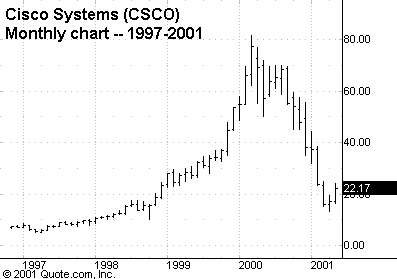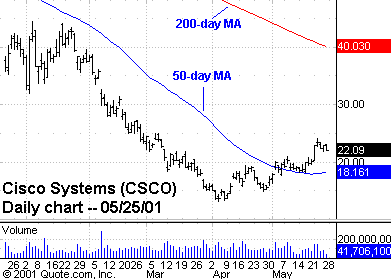Back From The Brink
While most tech investors spent a lot of the first quarter looking for some
clear sign that the tech debacle had finally run its course and that techs were
once again safe to buy, the market, as usual, accommodated very few. Analysts
kept saying that a final, massive wave of selling would signal a final
capitulation, but that never really occurred. Many market sages reminded us that
nobody rings a bell when a bottom is finally put in, and of course, they were
right because indeed, no bell rang.
The Nasdaq put in what looks like a pretty significant bottom on April 4 on
moderately heavy volume of 2.4 billion shares, and that was amid scores of
downgrades, visibility complaints, and worries of a far-too-aloof Fed. The
Nasdaq closed that day more than 3500 points below its March 10, 2000 high, and
has since put in nearly two months of constructive action that has put it 38%
above its lows. A cooperative and accommodating Fed seems eager to pump the
bubble back up lest we follow the dreadful 10-year bear path that Japan took
after its bubble popped in the late 1980s. So with the Fed behind stocks, and
the earnings outlook for tech likely to improve in the fourth quarter, it looks
like the worst is behind tech.
The Lawyers Descend
Another sure sign that we have put in a bottom are the legions of lawyers
swarming around the fine institutions that brought public such corporate gems as
AskJeeves, FreeMarkets.com, and Internet Capital Group. Whenever you see scores
of lawyers attacking every level of the investment industry food chain as well
as dozens of corporate boards of directors, you know that the madness that the
suits allege has most definitely been flushed out of the system. Even Cisco has
a flurry of angry shareholder suits against it.
In one set of cases, the SEC is investigating whether some underwriters
violated securities laws by requiring the companies’ brokerage customers to buy
shares in the aftermarket of an IPO in exchange for receiving an allocation or a
right to buy IPO shares at the original IPO price. This practice is known as
“laddering” and can artificially drive prices to heights where the
original IPO shareholders apparently were able to reap enormous profits. Wall
Street act greedy? Nah! My main point is that since much of the madness has
passed, it’s time for a tech turnaround.
Waiting For The Next Wave
The thing to keep in mind going forward is that “tech” is not just
a sector anymore, but rather a mass of small sub-sectors that are constantly
changing at the speed of light. The next wave will be led by a few of the past
leaders and some brand new names as well and will build on the tech
infrastructure that was put in place over the past five or so years. The bear in
tech has cleared out many of the bad ideas and has paved the way for new growth.
Granted, a lot of big money found its way into a lot of ridiculous ideas over the
past few years, but the thing to remember is that it got the Internet built. The
madness in the markets was the result what economist Joseph Schumpeter referred
to as “Creative Destruction” that is required in any dynamic economy
like the U.S.
Creative Destruction
There is a constant process of the new destroying the old, and Schumpeter,
who wrote in the early 20th century, argued that a capitalist economy had to
embrace that creative/destructive process in order for a country’s
economy to flourish. In today’s tech environment, the pace of creative
destruction moves at warp speed, and anyone that defends the old against the new
ends up as road kill. It’s not uncommon for techies to refer to one and two-year
old products as “legacy” or old products, and that shows just how
rapidly the creative/destructive process moves in our modern tech economy.
Even the venerable Cisco is under pressure to morph itself into an
optical-network-focused company since its routers are rapidly being rendered
obsolete by the onward march of technology progress. As the chart below shows,
Cisco solved the problem of linking everything on the Internet, and soared to a
massive $555 billion market cap, and has since suffered a crushing blow as its
creation is facing the destructive forces of technological change. This is the
model that tech will likely continue to follow in the coming years. The life and
death cycle of companies will continue to shorten, and we will likely see fewer
and fewer 100-year-old Ford Motors and more three-year-old Netscapes.
Â

The main challenge for John Chambers at Cisco now is to reinvent the company,
and he has a great chance at pulling that off given the many acquisitions the
company has made over the past few years. Microsoft and Intel have both
successfully made it through such metamorphoses, so I think Cisco could do the
same. Obviously, the market grew skeptical during the first quarter as techs
were routed, but don’t count Chambers & Company out yet.
Cisco’s Other Challenges
Cisco’s other problem is that it is facing stiff competition essentially from
itself. All of the billions of venture capital dollars that flowed into the
dot-com and networking mania allowed Cisco to sell a lot of product to a lot of
companies that never should have existed. Unfortunately for Cisco, a good chunk
of those products are brand new and being sold for pennies on the dollar over
the Internet, so Cisco’s profit squeeze could likely continue for some time. I
read of some of Cisco’s $50,000 server products selling for less than $2000 in
some online tech liquidation sites.

Cisco has staged a nice comeback from its April lows, and has pulled back
over the last few sessions on lighter volume. It’s also been constructive for
the stock to have regained its position back above its 50-day moving average.
Whether Cisco can ever battle back to its all-time high level of 81.75 remains
to be seen, but if there is one tech company that can pull off magical feats,
Cisco is probably the one. The networking giant remains one of the most
likely candidates with the skills and talent to engineer a creative
comeback from the brink of destruction.
Have a great Memorial Day.
Â
